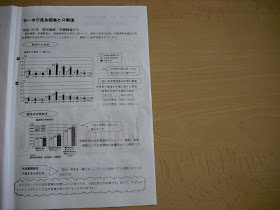This new kyushoku center caters for one junior high school and two elementary schools. Before the center was built, the junior high school and one of the elementary schools had their own kitchen on their respective premises, and the main reason why I wanted to participate in this event was that I wanted to know if anything had changed for the worse because of the change from the school kitchen system to the central kitchen system. On that particular day, the center made 1,130 meals in total. I learned from the nutrition teacher that the staff start making meals at 8:15 and finish making meals for the two elementary schools no later than 11:45 (and usually around 11:30) and finish making meals for the junior high around 12:00. Apparently, there seem to be no major changes for the worse. Reason: This particular kyushoku center is relatively small, and caters for only three schools, so the period from the time the meals are made until they are eaten can be kept short. In some large kyushoku centers that cater for more schools, the time difference is rather long.
The cost of the ingredients of the day's school lunch was 307 yen per meal, which must be covered by the parent under the School Lunch Program Law, while the equipment, labor, fuel, and other costs are covered by the municipality.
この新しい給食センターは中学校一校と小学校二校の給食を賄います。このセンターができる前は、中学校と、小学校二校のうち一校は敷地内に調理室がありました。私がこの会に参加したかった主な理由は、自校方式からセンター方式への変更で何か悪い方向に変わったかどうかを知りたかったからです。その日は、センターでは合計1,130食を作りました。栄養教諭からきいたところ、職員は8:15に作り始め、小学校二校の給食は遅くとも11:45までに(通常は11:30頃)作り終わり、中学校の給食は12:00頃に作り終わるそうです。見たところ、悪い変化はないようです。理由: この給食センターは比較的小さく、三校の給食しか作っておらず、給食ができてから食べるまでの時間を短く抑えられます。もっと多くの学校の給食を作る大きな給食センターでは、時間差はかなり長くなります。
その日の給食の食材費は一食当たり307円で、これは学校給食法に基づき、保護者が払い、設備費、人件費、光熱費などは市町村が払います。
Here are the materials the participants were given:
参加者に渡された資料です:
These photos are for those who can read Japanese. For those who don't and are interested in shokuiku (food education) in Japan, click here, you will find some valuable information.
これらの写真は日本語を読める人たち用です。読めないが、日本の食育に興味ある方は、ここをクリックしてください。有益な情報が載っています。
Finally, here are the kyushoku menus for July for the junior high school (right) and my daughter's elementary school (left). They list the same meals; only the portion sizes are different.
最後に、中学校(右)と娘の小学校(左)の7月の献立です。両方とも同じ食事で、量だけが異なります。






I learned something here;
ReplyDeletethe shokuiku is not only covers children dietary at school, but also gives knowledge about nutrition for the parent,
so the children also have a good nutrition balance at home too,
isn't it?
fred: Yes! Both parents and children are expected to learn about food!
ReplyDeleteHiroyuki, it's even more impressing now! You don't risk really transforming your population into people eating junk food... You know, in Europe the way the population eats and is conscious depends a lot on the country. From what I saw UK is one of the worst countries: when I watch BRitish programs about very obese children, who have never been given a raw vegetable at home and whose mothers (not working) have never cooked a home meal, it is scary... and so far from my experience, not to mention Japan.
ReplyDeleteWhat does the small boat on the last picture means (in nr 18)?
Sissi: July 18 is Umi no Hi (Marine Day) this year.
ReplyDeletehttp://en.wikipedia.org/wiki/Marine_Day
The boat symbolizes the ocean, I suppose.
Thanks for your explanation about the situations in Europe. Some of the junk foods school children have for lunch at school in the United States are just horrifying.
Thank you for the explanation! It looked very intriguing.
ReplyDelete